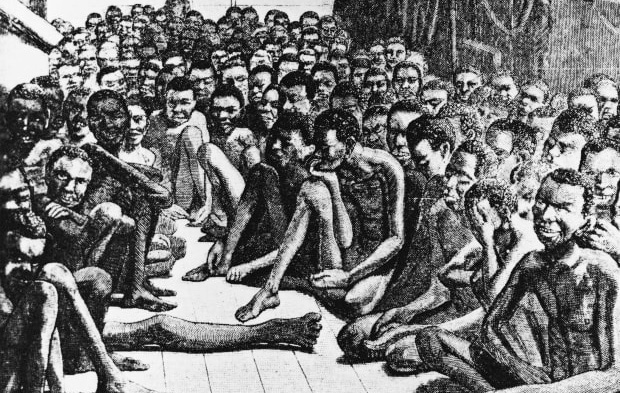Aftermath of chattel slavery: The Assins demand restitution out of Anglican Church Endowment Fund

On page 38 of Daily Graphic of Thursday, February 16, 2023, the Anglican Church has indicated its commitment of 100 million GBP (Great Britain Pounds) funding to countries that suffered grave casualties, as its show of unconditional remorse for its historical input in the Transatlantic Chattel slavery.
Indeed, it is so disheartening to recollect such reprehensible and dastardly event of chattel slavery that took place from the 16th to 18th centuries. Nonetheless, it is quite refreshing that the Anglican Church has set the stage by coming out boldly to exhibit such cogent repentance, based on historical antecedent that the church directly or indirectly contributed to these barbaric, callous and inhuman deeds.
As reiterated in my earlier submissions, writing the history of Trans-Atlantic slave trade would be inconclusive without tracing the originality of its root to Assins but most explicitly Assin Manso. The ultimate climax of Emancipation Day festivity at Manso where African ancestry from the diaspora yearly congregate to pay both spiritual and physical homage to ancestors, is a conspicuous demonstration of the relevance of Assin in its entirety within the annals of the country.
BRUTALITIES
The revelation of events that characterised the era of slavery, some centuries ago, cannot just be gloss over.
The chattel slavery in its totality witnessed the deliberate and gradual devastation of entire Assin enclave as the indigenous people, were forcibly cajoled to absolute submission, which culminated in subsequent privation and deprivation of their inalienable rights. It is indisputable fact that greater percentage of Human capital and resources that could have supported the people and indigenes to overcome its socio-economic woes, to bring about the required empowerment and to guarantee stronger coherence for the sake of posterity, virtually eluded the people until today.
History tells us that, those stronger folks including the erudite were the target of these slave brokers. They were bundled, tortured, maimed and ultimately subjugated our brothers and sisters for possible shipment to the Land of no return; leaving in its trail the orphaned, destitute, the feeble and the defenseless to their unpredictable fate.
Apparently, it is an irrefutable fact that Assin Manso particularly, bore the brunt of this brutish occurrence to the extremes, at the time. Hence, remnants of slavery in the form of ‘Donkorsuom’ i.e Slave River, the only watercourse designated for utilisation of slaves to have their ‘last bath’ before final conveyance to the dungeons in Cape coast and Elmina castles, awaiting arrival of vessels to the America’s and West Indies still persist till today. Besides, robust metal chains that were used to secure these slaves to hold them in check are as visible as we speak now.
‘Adakaboomu’, where human skeletons, obviously of the departed slaves, were given mass burial, are some of the visible remnants to substantiate the realities of Transatlantic chattel slavery are so noticeable upon a visit to this ancient settlement of Assin Manso. Unquestionably, Assin Praso, a town located at Assin North, equally suffered from these human butcheries.
Relics, in the form of mausoleum that served as entombment for slaughtered slaves is so conspicuous. Vestiges of these atrocities are so evident in couple of villages and towns within the district; thus giving real indications of grave challenge that confronted Assins in events that characterised Chattel slavery.
Today, the entire Assin enclave, which comprises of Assin south, Assin central and that of Assin North, considered as one of the largest single territory in Ghana are naturally deprived of massive economic boom as compared to other tribal territories of Ghana. This is as result of the heinous crime perpetrated in the era of slave trade, that has impoverishment the natives and subsequently contributed to deny the populace of required infrastructural growth, in areas of well-resourced hospitals, better school structures, good feeder roads, and even decent accommodation.
Nevertheless, ‘based on hindsight’ the Anglican church’s intention to commit such colossal capital to warrant new impact investment, grant funding, further research and responsible investment to address and combat modern slavery and human rights violations and to seek to address injustices and inequalities, are in my view, optimum strategic ingenuity pragmatically thought ‘outside the box’. The Anglican Church has just made its commitment. The expectation is that other churches, polities and wealthy organisations that directly or indirectly ‘soiled its image’ in the chronological events of the chattel slavery, should emulate the Anglican exceptional example by getting on board. It is not too late.
DEMAND FOR
RESTITUTION
In the light of these postulations, it is therefore advocated that, Assin Manso could serve as the focal point of these research works; certainly to be spearhead by the Anglican Church.
Clearly, the existence of a premium senior high school could be re-configured to house a vibrant research University department or faculty that would offer programmes focused on Slavery/Emancipation studies, its historical antecedents and associated pedagogical research works.
Reparation, in the form of scholarships to deserving students from Assin, having the opportunity to attend both local and foreign universities and colleges could add to guarantee the much-anticipated sustainable restitution.
Ultimately, siting local industries in the Assin enclave for the benefit of the youth, and besides resourcing the people with interest free loans could extricate the indigenes from seeming ‘vicious cycle of poverty’ influencing against their very existence. In this connection, we are calling on His Excellency the President of our cherished country, in tandem with the Anglican Church, to expedite processes that would see to the materialization of the positive impact to be derived from this impressive financial commitment.
[The writer is the Chief Executive Officer of Logistics Control Limited, Tema]
BY JOE EFFAH-NKYI



